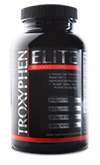
Nitric Oxide & Muscle
Nitric oxide, or Nitrogen Oxide, also known as Nitrogen Monoxide is an incredibly important cellular signaling molecule, found naturally in mammals, including humans. This particular molecule, whose chemical formula is NO, was discovered in the previous century, thanks to extensive research that was made in the field of vascular tone regulation and the relaxation of blood vessels. Initially classified as a endothelium-derived relaxing factor (EDRF), Nitric Oxide was thought of as a protein. The study which proved that this particular substance was an oxide – Nitric Oxide to be exact – resulted in a sudden spike of interest in the molecule. Countless thousands of papers on the subject of Nitric Oxide have been published since, and the the discovery of Nitric Oxide as a cardiovascular signalling molecule resulted in a Nobel Prize 17 years ago. Nitric Oxide has since been observed to greatly affect numerous processes of a biological nature that occur in our bodies, such as neurotransmission and the management of the death rate of cells.
 What Nitric Oxide does
What Nitric Oxide does
Nitric Oxide has several health benefits, but the most notable of these is its ability to increase the diameter of blood vessels. This property has made the molecule a sought-after bodybuilding drug. The way muscle growth works is, that when you make intensive use of your muscles for extended periods of time, microscopic ruptures appear in the muscle tissue. To put it simply, you literally rip your muscles apart. As opposed to most other tissue, when muscles heal themselves, the rely less on fusing together, and rather fill up the tear with new material, making the muscles more resistant, which means that next time they will be able to take more punishment. One typical rookie mistake in training, is shocking the muscles with additional training even after they are already in a damaged state. The muscles require a period of regeneration, when the healing of the tissue may happen. As Nitric Oxide expands the blood vessels, not only do we have significantly more energy during training, the healing-time of our muscles decreases, meaning we can train effectively more often.
Potential Side Effects and Dose
 Whenever you buy a Nitric Oxide Supplement product, the packaging, leaflet or label should contain all the necessary dosage information, as it varies from product to product. Side effects of Nitric Oxide may include fatigue, weakness, tiredness, nausea or diarrhea. This is due to the high concentration of arginine, which is an amino acid that happens to be the primary ingredient in most Nitric Oxide supplements. Everyone can tolerate a different level of argnine without experiencing detrimental effects, so make sure to consult a medical professional, and test out your limits by taking incrementally larger doses every week. This way you can change your dosage for the ideal amount.
Whenever you buy a Nitric Oxide Supplement product, the packaging, leaflet or label should contain all the necessary dosage information, as it varies from product to product. Side effects of Nitric Oxide may include fatigue, weakness, tiredness, nausea or diarrhea. This is due to the high concentration of arginine, which is an amino acid that happens to be the primary ingredient in most Nitric Oxide supplements. Everyone can tolerate a different level of argnine without experiencing detrimental effects, so make sure to consult a medical professional, and test out your limits by taking incrementally larger doses every week. This way you can change your dosage for the ideal amount.
Nitric Oxide made its debut as a bodybuilding supplement way back in 1996, and ahve only gained in popularity since. These products are available in two types : pills and soluble powder. The pills are more often than not composed of pure Nitric Oxide, while the powders contain additional healthy ingredients, like a wealth of vitamins, for example.
TOP 5
NITRIC OXIDESupplements |
|||||
| Nitric Oxide Premium | Troxyphen Elite | Ubervita | ANS | Mascugen | |
|---|---|---|---|---|---|
| 1 | 2 | 3 | 4 | 5 | |
| Price (1 bottle) Price (6 bottles) Best Value |
$48.00 $138.00 |
$69.99 $419.94 |
$19.95 $119.70 |
$129.99 $779.94 |
$39.99 $239.94 |
| Overall Rating | 99.40% | 86.90% | 78.90% | 74.70% | 68.00% |
| Effectiveness |





|





|





|





|





|
| Speed of Results | Extremely Fast | Good | Average | Average | Slow |
| Quality of Ingredients | Premium | Good | Good | Average | Unknown |
| Customer Satisfaction Evaluation | 99.20% | 84% | 76.20% | 72% | 66.30% |
| Safety Evaluation | Safe for Use | Safe for Use | Safe for Use | Safe for Use | Safe for Use |
| Customer Service Rating |





|





|





|





|





|
| Reorder Rate | Highest | Good | Good | Average | Average |
| Return Policy | Risk Free | Single Bottle Only | Unclear | Unclear | Unclear |
| Success Rate | 99.40% | 82.10% | 76% | 73.20% | 65% |

 Subscribe Now
Subscribe Now











